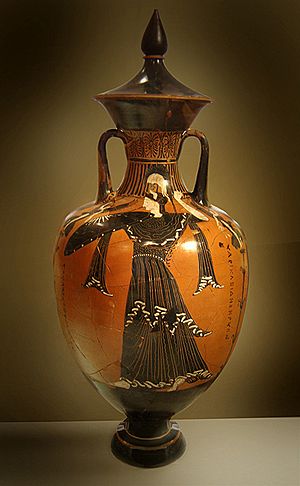Panathenaic amphora facts for kids

Panathenaic amphorae were special large ceramic vases. They held olive oil given as prizes in the Panathenaic Games, a big festival in ancient Athens. These vases were quite tall, about 60 to 70 centimeters (around 2 feet). The olive oil came from a sacred olive grove dedicated to the goddess Athena in a place called Akademia.
These amphorae had a unique shape with tight handles, a narrow neck, and a small base. They were always decorated in a specific way using the black figure style. This style showed black shapes against a red background. Even when other pottery styles became popular, Panathenaic amphorae kept their traditional look.
One side of the vase usually showed Athena Promachos, the goddess of war. She was shown holding a spear and wearing her special shield, the aegis. Next to her, it said in Greek: "one of the prizes from Athens." The other side of the vase showed the event for which the prize was given, like a race or a wrestling match. Sometimes, roosters were shown on top of the columns next to Athena. Why they were there is still a mystery! Later vases also had the name of the city's leader (called an archon) from that year. This helps historians and archaeologists date the vases very accurately.
Contents
Panathenaic Amphorae: Prizes of Ancient Games
What Were These Special Vases?
Panathenaic amphorae were not just any pots. They were official prizes for the winners of the Panathenaic Games. These games were a huge festival held every four years in ancient Athens, similar to the Olympic Games. The prizes were filled with valuable olive oil from Athena's sacred trees.
How Were They Made?
The city of Athens ordered these vases from the best pottery workshops. This meant they were made by skilled artists. The standard shape of these vases was set around 530 BC. The earliest known example is called the Burgon vase. It shows Athena's owl on its neck and a chariot team on the back. This vase might even be older than the festival's big reorganization in 566 BC.
One artist named Exekias was the first to show a rooster on the columns next to Athena on a Panathenaic amphora. Later, around the early 300s BC, the name of the city's leader, the archon, started appearing on the vases. The oldest nearly complete vase with an archon's name is from 373/2 BC.
A Look at Their History
Over time, the shape of the vases became longer and the decorations more detailed. The last known dated vase is from 312/11 BC. However, these vases continued to be made into the 200s BC. After a while, the archon's name was no longer written on them. Instead, the names of the game's treasurers and organizers were recorded.
Where Are They Now?
Many of these special vases have been found all over the ancient Greek world. Some were placed in tombs with the winners, like a special treasure. Others were given as gifts to temples or sold. This is why we find them in so many different places today!
Images for kids
See also
 In Spanish: Ánfora panatenaica para niños
In Spanish: Ánfora panatenaica para niños


